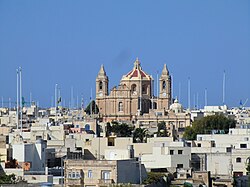Ghaxaq
|
Għaxaq Ħal Għaxaq Asciak |
|||
|---|---|---|---|
| Local council | |||

Għaxaq skyline
|
|||
|
|||
| Motto: Laeta Sustineo | |||
 |
|||
| Coordinates: 35°50′54″N 14°31′2″E / 35.84833°N 14.51722°ECoordinates: 35°50′54″N 14°31′2″E / 35.84833°N 14.51722°E | |||
| Country |
|
||
| Region | Southern Region | ||
| District | South Eastern District | ||
| Borders | Birżebbuġa, Gudja, Luqa, Marsaxlokk, Santa Luċija, Tarxien, Żejtun, Żurrieq | ||
| Government | |||
| • Mayor | Darren Abela (PL) | ||
| Area | |||
| • Total | 3.9 km2 (1.5 sq mi) | ||
| Population (March 2014) | |||
| • Total | 4,722 | ||
| • Density | 1,200/km2 (3,100/sq mi) | ||
| Demonym(s) | Għaxqi (m), Għaxqija (f), Għaxqin (pl) | ||
| Time zone | CET (UTC+1) | ||
| • Summer (DST) | CEST (UTC+2) | ||
| Postal code | GXQ | ||
| Dialing code | 356 | ||
| ISO 3166 code | MT-17 | ||
| Patron saint | Assumption of Our Lady | ||
| Day of festa | 15 August | ||
| Website | Official website | ||
Għaxaq (Maltese: Ħal Għaxaq, Maltese pronunciation: [ħal aːʃaʔ]) is a village in the Southern Region of Malta, with a population of 4,722 people as of March 2014. It is mainly a residential area surrounded by land used for agricultural purposes. The village's name is probably related to the noble family named Axiaq (also spelt Axiak or Asciak) which had feudal lands in the area in the fourteenth century, or it may be derived from the Maltese word meaning delight.
The village's main church is dedicated to the Assumption of Mary, popularly known in Maltese as Santa Marija, which is therefore the village's patron saint. Celebrations take place annually from 30 July to 15 August. A secondary feast is celebrated on the week before the first Sunday of June. This is dedicated to Saint Joseph, husband of Mary. During these feasts the village is decorated with highly artistic statues and colourful lights and banners.
Għaxaq's main church is dedicated to the Assumption of Our Lady and it is renowned for its beautiful baroque architecture. The present church was consecrated on 2 May 1784, after around 50 years of hard work by the villagers, which gave a helping hand in building their religious shrine. One could find a large number of artistic and valuable items in this church which were made by renowned Maltese and foreign artists. Of these one could find a number of highly artistic statues which all seek great devotion in a way or another. The titular statue which depicts the Assumption in heaven of our Lady was carved in wood by Maltese Mariano Gerada in 1808 and it is quite popular for its beauty and considered, not only as one of the artist's masterpieces but also one of the most beautiful statues in Maltese Churches. Another statue which could be found in this church is that of the Main Secondary Feast of Saint Joseph which was made by Fratelli Bertarelli of Milan in Italy in the year 1932 and is also carved in wood. Other statues are those of Our Lady of the Rosary carved in wood by Alessandro Farrugia, Our Lady of Fátima and a set of traditional eight statues depicting the passion of Jesus Christ. These were made throughout the years with statues of Maltese artists Peppi Vella,Carlo Darmanin and family Camilleri Cauchi, namely Alfred and Aaron Camilleri Cauchi. The statue of dead Christ known as Il-Monument was brought to Għaxaq from Rome in the 18th century. The paintings which decorate the church's ceiling were painted by Emvin Cremona during the 1960s while other works of art date back to the 16th, 17th and 18th centuries mostly painted by famous Maltese artists; Gian Nikol Buhagiar, Francesco Zahra, Rokku Buhagiar and Ganni Vella above others. Apart from the Titular feast of Saint Mary which is celebrated annually on 15 August, other feasts are celebrated along the year. These are; the commemoration of the Passion of Jesus Christ and his rise from dead- with the traditional Good Friday procession, which in Għaxaq is held on Palm Sunday evening, celebrated a Sunday before Easter, the Main Secondary feast of Saint Joseph celebrated on the 1st Sunday of June, Corpus Christi on the 2nd Sunday of June and Our Lady of the Rosary on the 2nd Sunday of October. These are all organised by their respective confraternities. Last but not least, on the night between 24 and 25 December, a solemn mass is held to celebrate Christmas.
...
Wikipedia


